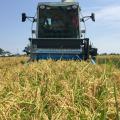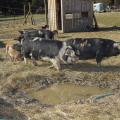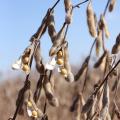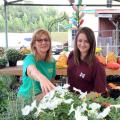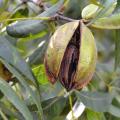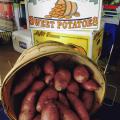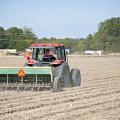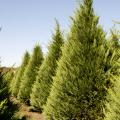Crop Report from 2015
STONEVILLE, Miss. -- Rice harvest has begun in Mississippi, but only time will tell how many acres were actually planted and how good yields will be.
“There’s not a lot of yield reports yet, but I think we’re going to have a good crop,” said Bobby Golden, rice agronomist with the MSU Extension Service and researcher with the Mississippi Agricultural and Forestry Experiment Station. “It probably won’t be as good as last year, but we set records the last two years running.”
STARKVILLE, Miss. -- Sod supply in Mississippi is slowly rebounding in 2015 after a major shortage of the commodity last year.
Jay McCurdy, turfgrass specialist with the Mississippi State University Extension Service, said turfgrass remains in short supply this year due to a decline in acreage and recent harsh winters.
STARKVILLE, Miss. -- Mississippi farmers planted more peanuts in response to economic factors that made the crop an attractive choice this year, but a lack of rain now has them expecting average yields.
Mississippi has 42,000 acres of peanuts this year, up 45 percent from what was planted in 2014. The U.S. Department of Agriculture estimates 84 percent of the crop is in fair to good condition.
STARKVILLE, Miss. -- Low feed costs and steady demand are keeping the playing field level for Mississippi swine producers, but the bottom line at year’s end will be down from 2014 totals.
Mississippi’s value of production for hogs was $153 million last year. No estimates are available for 2015, but hog prices have been much lower than they were in 2014, while hog numbers were higher at the first of the year.
STARKVILLE, Miss. -- After causing significant challenges in 2014, sugarcane aphids did not catch Mississippi’s grain sorghum growers by surprise this year.
“We are not sure if sugarcane aphids were not as bad as last year or if we just did a better job using insecticidal seed treatments,” said Angus Catchot, an entomologist with the Mississippi State University Extension Service. “One big difference was that we were more educated in our control efforts. No one was caught by surprise, and everyone had budgeted for control.”
STARKVILLE, Miss. -- Erratic yields in Mississippi’s early-planted soybean crop reflect the extremes of temperature and rainfall farmers faced during the spring and summer of 2015.
“This season was one of extremes,” said Trent Irby, soybean specialist with the Mississippi State University Extension Service. “We went from cool, wet conditions in early spring to hot and dry during a critical point of the season, and that has taken a toll on yield for some of our acres.”
STARKVILLE, Miss. -- If inquiries about new or expanded businesses are the heartbeat of Mississippi horticulture, then agricultural economist Alba Collart knows 2015 is a healthy year for the industry.
Collart, assistant professor of agricultural economics with the Mississippi State University Extension Service, said horticultural crops are important to Mississippi’s agricultural economy. These specialty crops include fruits, vegetables, tree nuts and products grown for environmental horticulture, also known as the green industry.
RAYMOND, Miss. -- Despite a wet spring followed by a dry summer and fall, Mississippi should have average pecan yields in 2015.
STARKVILLE, Miss. -- Mississippi pumpkin growers live for conditions like they have seen in 2015.
VARDAMAN, Miss. -- Untimely dry conditions will likely hurt this year’s sweet potato crop in Mississippi, but increasing demand is keeping prices high enough for growers to remain optimistic.
Stephen Meyers, sweet potato specialist with the Mississippi State University Extension Service, said a wet spring delayed planting for one to two weeks. Dry fall conditions limited growing progress and will keep yields from reaching full potential.
STARKVILLE, Miss. -- Mississippi farmers are expected to plant as much as 200,000 acres of wheat this year, but very little had been planted by the end of October because of exceptionally dry weather since August.
Erick Larson, grain crops agronomist with the Mississippi State University Extension Service, said several factors limited wheat acreage last year, but wheat planting intentions are fairly strong this year if weather allows planting to proceed soon.
SAUCIER, Miss. -- Christmas tree growers in Mississippi expect a 7 percent increase in sales this year, but unfavorable spring and fall weather may hurt future supplies.
Stephen Dicke, a forestry professor with the Mississippi State University Extension Service, said growers successfully controlled insect and disease problems this year. However, a wet spring followed by a dry summer and early fall caused some growers to lose up to half of their 1-year-old trees.

